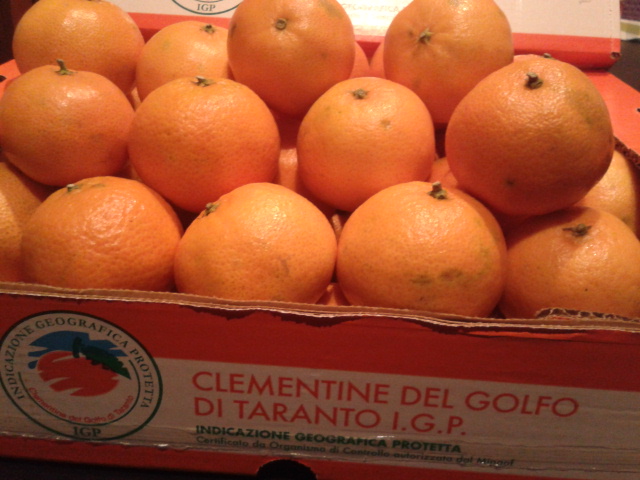|
Fairchild (fruit)
The Fairchild tangerine is a cross between a Clementine mandarin and an Orlando tangelo. The skin is thin with a deep orange color, is somewhat pebbly, and doesn't peel as easily as some other tangerines. It is juicy with a rich and sweet flavour and contains seeds. It is a popular variety in the United States, available from October until the middle of January and especially during the winter holidays. The Fairchild tangerine is one of California's most heavily planted varieties. Fairchild tangerines are sometimes found with the stem and leaves still attached. The Chinese believe the stems and leaves attached to the tangerine are a symbol of prosperity and good luck. See also *Mandarin orange *Citrus taxonomy Citrus taxonomy is the botanical classification of the species, varieties, cultivars, and graft hybrids within the genus ''Citrus'' and related genera, found in cultivation and in the wild. Citrus taxonomy is complex and controversial. Cultiva ... References Ext ... [...More Info...] [...Related Items...] OR: [Wikipedia] [Google] [Baidu] |
Citrus Reticulata
A mandarin orange (''Citrus reticulata''), often simply called mandarin, is a small, rounded citrus tree fruit. Treated as a distinct species of orange, it is usually eaten plain or in fruit salads. The mandarin is small and oblate, unlike the roughly spherical sweet orange (which is a mandarin-pomelo hybrid). The taste is sweeter and stronger than the common orange. A ripe mandarin orange is firm to slightly soft, heavy for its size, and pebbly-skinned. The peel is thin and loose, with little white mesocarp, so they are usually easier to peel and to split into segments. Hybrids have these traits to lesser degrees. The mandarin orange is tender and is damaged easily by cold. It can be grown in tropical and subtropical areas. According to genetic studies, the wild mandarin was one of the original citrus species; through breeding or natural hybridization, it is the ancestor of many hybrid citrus cultivars. With the citron and pomelo, it is the ancestor of the most commerciall ... [...More Info...] [...Related Items...] OR: [Wikipedia] [Google] [Baidu] |
Orlando Tangelo
The tangelo ( , ; ''C. reticulata × C. maxima'' or ''× C. paradisi''), ''Citrus × tangelo'', is a citrus fruit hybrid of a ''Citrus reticulata'' variety, such as mandarin orange or tangerine, and a ''Citrus maxima'' variety, such as a pomelo or grapefruit. The name is a portmanteau of 'tangerine' and 'pomelo'. Tangelos are the size of an adult fist, have a tart and tangy taste, and are juicy (with less flesh inside). They generally have loose skin and are easier to peel than oranges, readily distinguished from them by a characteristic bump at the stem. Tangelos can be used as a substitute for mandarin oranges or sweet oranges. Varieties Orlando The early maturing Orlando tangelo is noted for its rich juiciness, mild and sweet flavor, large size, distinct zesty smell, and flat-round shape without a characteristic knob. Orlando tangelos are available from mid-November to the beginning of February. The tangelo originated as a cross between a Duncan grapefruit and a Danc ... [...More Info...] [...Related Items...] OR: [Wikipedia] [Google] [Baidu] |
Indio, California
Indio (Spanish language, Spanish for "Indian") is a city in Riverside County, California, United States, in the Coachella Valley of Southern California's Colorado Desert region. Indio is approximately east of Los Angeles, east of Palm Springs, California, Palm Springs, and west of Blythe, California. The population was 89,137 in the 2020 United States census, up from 76,036 at the 2010 United States Census, 2010 census, an increase of 17%. Indio is the most populous city in the Coachella Valley, and was formerly referred to as the "Hub of the Valley," a Chamber of Commerce slogan used in the mid-twentieth century. Indio is now nicknamed the "City of Festivals," a reference to the numerous cultural events held in the city, most notably the Coachella Valley Music and Arts Festival and Stagecoach Festival. Indio is the principal city of an urban area defined by the United States Census Bureau that is located in the Coachella Valley: the Indio–Palm Desert, California, Palm Dese ... [...More Info...] [...Related Items...] OR: [Wikipedia] [Google] [Baidu] |
Clementine
A clementine (''Citrus × clementina'') is a tangor, a citrus fruit hybrid between a willowleaf mandarin orange ( ''C.'' × ''deliciosa'') and a sweet orange (''C. × sinensis''), named in honor of Clément Rodier, a French missionary who first discovered and propagated the cultivar in Algeria. The exterior is a deep orange colour with a smooth, glossy appearance. Clementines can be separated into 7 to 14 segments. Similar to tangerines, they tend to be easy to peel. They are typically juicy and sweet, with less acid than oranges. Their oils, like other citrus fruits, contain mostly limonene as well as myrcene, linalool, α-pinene and many complex aromatics. They are sometimes sold under the name Easy-peelers. History The clementine is a spontaneous citrus hybrid that arose in the late 19th century in Misserghin, Algeria, in the garden of the orphanage of the French Missionary Brother Clément Rodier, for whom it would be formally named in 1902. Some sources have at ... [...More Info...] [...Related Items...] OR: [Wikipedia] [Google] [Baidu] |
Orange (colour)
Orange is the colour between yellow and red on the spectrum of visible light. The human eyes perceive orange when observing light with a dominant wavelength between roughly 585 and 620 nanometres. In traditional colour theory, it is a secondary colour of pigments, produced by mixing yellow and red. In the RGB colour model, it is a tertiary colour. It is named after the orange (fruit), fruit of the same name. The orange colour of many fruits and vegetables, such as carrots, pumpkins, sweet potatoes, and Orange (fruit), oranges, comes from carotenes, a type of photosynthetic pigment. These pigments convert the light energy that the plants absorb from the Sun into chemical energy for the plants' growth. Similarly, the hues of autumn leaves are from the same pigment after chlorophyll is removed. In Europe and the United States, surveys show that orange is the colour most associated with amusement, the unconventional, extroversion, warmth, fire, energy, activity, danger, taste and a ... [...More Info...] [...Related Items...] OR: [Wikipedia] [Google] [Baidu] |
Tangerine
The tangerine is a type of citrus fruit that is orange in colour, that is considered either a variety of the mandarin orange (''Citrus reticulata''), or a closely related species, under the name ''Citrus tangerina'', or yet as a hybrid (''Citrus'' × ''tangerina'') of mandarin orange varieties, with some pomelo contribution. Etymology The word "tangerine" was originally an adjective meaning "of Tangier", a Moroccan seaport on the Strait of Gibraltar. The name was first used for fruit shipped from Tangier, described as a mandarin variety. The OED cites this usage from Joseph Addison, Addison's ''Tatler (1709), The Tatler'' in 1710 with similar uses from the 1800s. The fruit was once known scientifically as "''Citrus nobilis'' var. ''tangeriana''"; it grew in the region of Tangiers. This usage appeared in the 1800s. Taxonomy Under the Citrus taxonomy, Tanaka classification system, ''Citrus tangerina'' is considered a separate species. Under the Citrus taxonomy, Swingle sy ... [...More Info...] [...Related Items...] OR: [Wikipedia] [Google] [Baidu] |
Flavour (taste)
The gustatory system or sense of taste is the sensory system that is partially responsible for the perception of taste. Taste is the perception stimulated when a substance in the mouth reacts chemically with taste receptor cells located on taste buds in the oral cavity, mostly on the tongue. Taste, along with the sense of smell and trigeminal nerve stimulation (registering texture, pain, and temperature), determines flavors of food and other substances. Humans have taste receptors on taste buds and other areas, including the upper surface of the tongue and the epiglottis. The gustatory cortex is responsible for the perception of taste. The tongue is covered with thousands of small bumps called papillae, which are visible to the naked eye. Within each papilla are hundreds of taste buds. The exceptions to this is the filiform papillae that do not contain taste buds. There are between 2000 and 5000Boron, W.F., E.L. Boulpaep. 2003. Medical Physiology. 1st ed. Elsevier Science U ... [...More Info...] [...Related Items...] OR: [Wikipedia] [Google] [Baidu] |
Citrus Taxonomy
Citrus taxonomy is the botanical classification of the species, varieties, cultivars, and graft hybrids within the genus ''Citrus'' and related genera, found in cultivation and in the wild. Citrus taxonomy is complex and controversial. Cultivated citrus are derived from various citrus species found in the wild. Some are only selections of the original wild types, many others are hybrids between two or more original species, and some are backcrossed hybrids between a hybrid and one of the hybrid's parent species. Citrus plants hybridize easily between species with completely different morphologies, and similar-looking citrus fruits may have quite different ancestries. Some differ only in disease resistance. Conversely, different-looking varieties may be nearly genetically identical, and differ only by a bud mutation. Genomic analysis of wild and domesticated citrus cultivars has suggested that the progenitor of modern citrus species expanded out of the Himalayan foothills in a ... [...More Info...] [...Related Items...] OR: [Wikipedia] [Google] [Baidu] |
Citrus
''Citrus'' is a genus of flowering trees and shrubs in the family Rutaceae. Plants in the genus produce citrus fruits, including important crops such as oranges, mandarins, lemons, grapefruits, pomelos, and limes. ''Citrus'' is native to South Asia, East Asia, Southeast Asia, Melanesia, and Australia. Indigenous people in these areas have used and domesticated various species since ancient times. Its cultivation first spread into Micronesia and Polynesia through the Austronesian expansion (–1500 BCE). Later, it was spread to the Middle East and the Mediterranean () via the incense trade route, and from Europe to the Americas. Renowned for their highly fragrant aromas and complex flavor, citrus are among the most popular fruits in cultivation. With a propensity to hybridize between species, making their taxonomy complicated, there are numerous varieties encompassing a wide range of appearance and fruit flavors. Evolution Evolutionary history The large cit ... [...More Info...] [...Related Items...] OR: [Wikipedia] [Google] [Baidu] |



